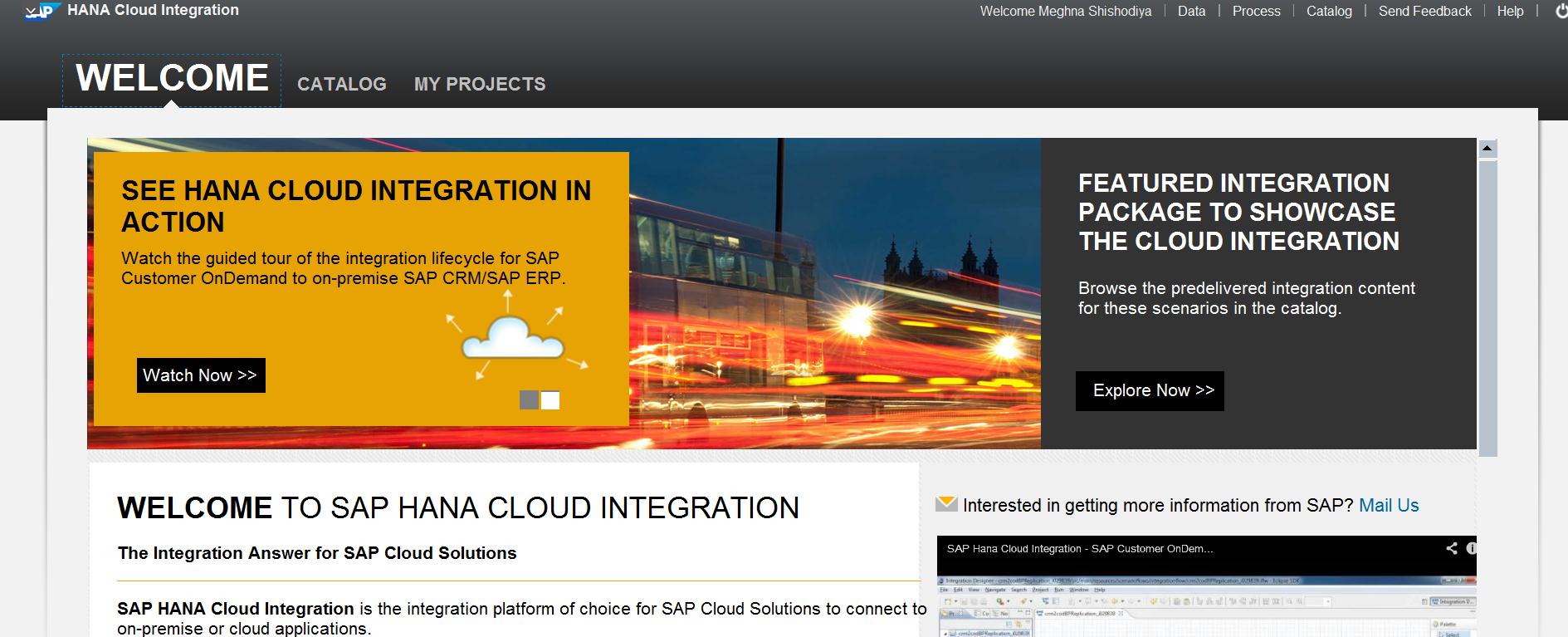
- SAP Community
- Products and Technology
- Technology
- Technology Blogs by SAP
- HANA Cloud Integration: Getting Started
- Subscribe to RSS Feed
- Mark as New
- Mark as Read
- Bookmark
- Subscribe
- Printer Friendly Page
- Report Inappropriate Content

HANA Cloud Integration
Introduction
Why on-demand integration:
The growing complexity of customer processes puts a lot of complex requirement on their landscape. In addition to having solutions from various vendors, customer environments now comprise of a combination of on-premise and on-demand solutions. SAP recognizes that it is crucial to provide integration to make such a hybrid solution landscape work. To address this need, SAP delivers a cloud-based integration technology as a managed service (Platform as a service [PaaS]) on top of SAP HANA Cloud to provide out-of-the-box connectivity between on-demand solutions and other SAP on-premise or on-demand solutions. It provides both process and data integration capabilities.
What is HANA Cloud Integration:
HANA Cloud Integration is a collection of tools, environment and platform that you will use to design, develop, build, deploy, run, administer and monitor the integration content.
Additionally, SAP provides a collection of pre-configured content for SAP to SAP integration to provide out-of-the-box connectivity between SAP applications. In order to foster ease of consumption, it is ensured that HANA Cloud Integration uses the same content as PI. This ensures that all your prior investments in PI content (if any) are intact. It also ensures a steep learning curve and lesser time to get the first scenario running.
Extensive process steps are provided for you to design your integration. This includes: content based routing, mapping, encoding, decoding, filtering, enriching, encryption, signing, verifying, decryption and splitter.
Architecture:
HANA Cloud Integration provides a multi-tenant architecture provisioned on an oSGi based implementation. This ensures an autonomous, independent and highly secure environment for each participant. The runtime entity is referred to as a tenant and it comprises of management and worker nodes.
The ESB supports pattern based integration. More patterns are added from time to time.
The modeling environment is based on BPMN 2.0.
Interfaces:
In order to perform these tasks, SAP provides 2 interfaces:
1) Eclipse based environment meant for the integration developers: here you configure, deploy, administer and monitor your integration flows. You can also use this to create new camel components going forward.
The Eclipse Juno 4.2 release is used for this purpose.

2) HTML 5 based WebUI meant for an Integration Experts: SAP provides pre-configured content for SAP to SAP integration. All such pre-delivered content can be discovered from the WebUI. The content can directly be the deployed from the WebUI to your runtime. It also allows you to customize some parameters of the pre-configured iflow before it is deployed.

Supported connectivity:
Currently HANA Cloud Integration supports the following connectivity:
- SOAP
- sFTP
- IDoc over SOAP
- SuccessFactor (planned for release in Dec’13). It is a dedicated adapter to integrate with SuccessFactor applications.
- REST (planned)
- OData (planned)
HANA Cloud Integration Flavors:
Currently HANA Cloud Integration can be licensed as:
- Application Edition: i.e. only with the application systems that are currently supported by it.
- Financial Services Network: a very specific usecase meant for exchange of financial information between a financial institute and it’s connected corporate.
In the future, you can however expect HANA Cloud Integration to be available also in Platform Edition.
The SAP Mobile Platform (planned) is also based on HANA Cloud Integration.
The next blog will cover details about the supported Application systems.
Would you like to try this offering? Please contact Meghna Shishodiya for more details.
- SAP Managed Tags:
- SAP HANA
You must be a registered user to add a comment. If you've already registered, sign in. Otherwise, register and sign in.
-
ABAP CDS Views - CDC (Change Data Capture)
2 -
AI
1 -
Analyze Workload Data
1 -
BTP
1 -
Business and IT Integration
2 -
Business application stu
1 -
Business Technology Platform
1 -
Business Trends
1,658 -
Business Trends
92 -
CAP
1 -
cf
1 -
Cloud Foundry
1 -
Confluent
1 -
Customer COE Basics and Fundamentals
1 -
Customer COE Latest and Greatest
3 -
Customer Data Browser app
1 -
Data Analysis Tool
1 -
data migration
1 -
data transfer
1 -
Datasphere
2 -
Event Information
1,400 -
Event Information
66 -
Expert
1 -
Expert Insights
177 -
Expert Insights
293 -
General
1 -
Google cloud
1 -
Google Next'24
1 -
Kafka
1 -
Life at SAP
780 -
Life at SAP
13 -
Migrate your Data App
1 -
MTA
1 -
Network Performance Analysis
1 -
NodeJS
1 -
PDF
1 -
POC
1 -
Product Updates
4,577 -
Product Updates
341 -
Replication Flow
1 -
RisewithSAP
1 -
SAP BTP
1 -
SAP BTP Cloud Foundry
1 -
SAP Cloud ALM
1 -
SAP Cloud Application Programming Model
1 -
SAP Datasphere
2 -
SAP S4HANA Cloud
1 -
SAP S4HANA Migration Cockpit
1 -
Technology Updates
6,873 -
Technology Updates
419 -
Workload Fluctuations
1
- Consuming SAP with SAP Build Apps - Mobile Apps for iOS and Android in Technology Blogs by SAP
- Configure SAP BTP destination REST API integration - Document information extraction - "AxiosError: in Technology Q&A
- Support for API Business Hub Enterprise in Actions Project in Technology Blogs by SAP
- Demystifying the Common Super Domain for SAP Mobile Start in Technology Blogs by SAP
- How to improve the ADT Class Runner with additional Features in Technology Blogs by Members
| User | Count |
|---|---|
| 35 | |
| 25 | |
| 14 | |
| 13 | |
| 7 | |
| 7 | |
| 6 | |
| 6 | |
| 5 | |
| 5 |